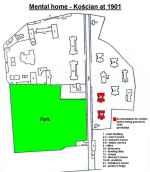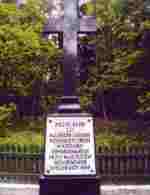In Poland the Nazi euthanasia actions are called "Pseudo-Euthanasia".
Koscian (47 km from
Poznan) was one of the
first places where Nazi euthanasia actions took place, even before such measures had commenced in Germany and Austria.
The reasoning behind the "cleaning" of the Polish mental homes surely was almost certainly to obtain space for German
troops at the beginning of the war.
 |
| Koscian Mental Home |
The
Koscian Bernardine Monastery was built
between 1603
and 1611. Its buildings had been used as a mental home since
1827, at the time
of the Prussian annexation of Poland. The patients were housed in terrible conditions. They were confined in solitary
cells with concrete floors, living in their own excrement. The new chief of the hospital, Dr
Oskar Bielawski, brought about better conditions and introduced modern methods
of treatment from
October 1929.
In
early 1940* the hospital was taken
over by the
SS Sonderkommando Lange and the
Gau-Selbstverwaltung
(German Council Association) from Poznan. The Polish
medical personnel* were dismissed,
leaving behind 612 Polish patients.
Now the hospital was administered by Dr
Johann Keste (psychiatrist),
Dr.
Fritz Lemberger (gynaecologist),
Hans Meding
(medical inspector) and
Wilhelm Haydn (chief of the male nurses), killers in
white doctor’s gowns.
 |
| Mental Home Map |
In
early January 1940, an
SS Sonderkommando arrived, carrying a dark brown
bottle containing a morphine-scopolamine mixture, used to calm the victims.
Probably on
15 January 1940, the first group of naked patients received an injection
and were bundled into a mobile gas chamber (gas van or gas trailer) inscribed with an advertisement for
"
Kaiser's Kaffee Geschäft". Of course,
Kaiser's Coffee Company was not involved in the action.
The van's (or trailer's) inner sides were lined with metal sheets, the floor was covered with a wooden grate and a
lamp on the ceiling illuminated the gas chamber for inspection through a peephole in the back door.
When the driver (an SS man) started the vehicle's engine, the exhaust fumes were emitted into the loading space.
The victims screamed loudly before they died. Then the gas van drove
from Koscian to Jarogniewice Forest (a site on the road
Koscian - Poznan, about 15-20 km north of
Koscian).
After 15-20 minutes the van finally reached the forest, and nobody in the gas chamber was left alive.
At Jarogniewice Forest prisoners (probably Jews from KZ
Fort VII in
Poznan) opened the
back doors of the gas van and buried the corpses in mass graves. One week later (on
22 January
1940) a second group of patients were killed in an identical fashion. The same van was later used
(in
March 1940 and July/August 1941) at the
Kochanowka
Hospital near
Lodz. Apart from mentally handicapped patients, blind
children from
Lodz were killed at this time.
 |
| Jarogniewice Memorial |
Within that week, all in all, 534 patients had been killed - 237 men and 297 women. However, this was only the
beginning of a more extensive action in
Koscian. On
9
February a transport
from Germany with 2,750 Jewish and non-Jewish patients from mental and old
people's homes arrived in
Koscian. All were killed in the same manner as the
first patients. It is most likely that
on 24 February 1940 the last transport left
Koscian
Hospital for
Jarogniewice Forest. In total, 3,334 patients lost their
lives in course of this euthanasia action in
Koscian.
In
June 1940, officers arrived from the
Zentrale für Krankenverlegung
(Central Office for Transfer of Sick Persons), located in
Kalisz. They sent
fictitious death certificates to the victims' families to allay any
suspicions. On blank forms containing a standard wording ("death was caused by...") fabricated causes of death such
as apoplexy, heart attack, etc. were intended to veil the crime. In the mental home's cemetery bogus graves were
created. Cemetery fees were even charged to the relatives. The hospital in
Pruszkow
near
Warsaw was also used as a fictitious place to where the patients had been
allegedly transferred, and there died of natural causes.
On
25 February 1944, 25 SS men of the
SS Sonderkommando
Bothmann from
Poznan arrived in the vicinity
of
Jarogniewice village. Among them were
Frank, Grimm,
Haase, Klaus, Rollmann, Rubner (Rübner?), Schneider, Schwarz and Zimmermann1.
They exhumed the corpses, cremated them in mass graves and/or destroyed them by means of slaked lime mixed with water,
scattered the ashes in the forest and planted spruces to camouflage the
former mass graves*.
Similar euthanasia actions took place at other mental homes in Poland: in
Warta,
Owinska, Poznan Fort VII,
Tworki in
Pruszkow,
Gostynin,
Kobierzyn near
Krakow,
Dziekanka in
Gniezno,
Otwock near
Warsaw,
Kocborowo in
Starogard Gdanski,
Kochanowka near
Lodz,
Chelm near
Lublin,
Choroszcz near
Bialystok,
Lubliniec near
Czestochowa,
Obrzyce (former German
Meseritz-Obrawalde) near
Miedzyrzecz,
and at other hospitals.
The killings were not always disguised. In the
Chelm Lubelski Hospital, patients
(128 women, 304 men and 18 children) were simply machine-gunned at the entrances to the wards and buried in the
hospital grounds in two large pits, under the eyes of the Polish hospital staff. The SS needed the buildings for their
quarters. In
January 1940, 23 patients from a private asylum in
Iwonicz, which belonged to the
monastery of St.
John, were taken to the
Warzyce forest near
Jaslo and shot, to make room for the SS Battalion "Galizien".
At least 13,000 Polish patients were murdered in this fashion, and an unknown number starved to death during the
occupation of Poland.
Poland was also a killing field for German patients. One of the execution sites was at
Piasnica near Wejherowo, where around 1,200 patients from nearby German psychiatric
institutions (and from
Stralsund, Ueckermünde, Treptow and
Lebork hospitals) were killed.
Prof. Stanislaw Batawia / Poland listed the following
dates about euthanasia killings in Poland (GKBZH No 3/1947):
Owinska Mental Home (near
Poznan): 15 September - 20 December 1939.
Victims: 1,100
Swiecie Mental Home (near Bydgoszcz): September -
October 1939. Victims: 1,350
Kocborowo Mental Home: 29 November -
20 December 1939. Victims: 2,342
Gniezno Mental Home: December 1939, January 1940,
June 1941. Victims: 1,201
Chelm Mental Home: 12 January 1940. Victims: 440
Koscian Mental Home: January - February 1940.
Victims: 3,334
Gostynin Mental Home (near Warszawa):
3 February - 3 July 1940, 9 July. Victims: 107
Kochanowka Mental Home (near
Lodz): 13 - 15 March 1940, 27 - 28 March 1940,
June - August 1940. Victims: 629
Warta Mental Home (near
Sieradz): 2 - 4 April 1940. Victims: 499
Choroszcz Mental Home (near
Bialystok): 1941. Victims: 464
Kobierzyn Mental Home (near
Krakow): 23 July 1942. Victims: 500
Otwock Mental Home (near
Warszawa): August 1942. Victims: unknown
Lubliniec Mental Home (near Czestochowa): August 1942 -
November 1944. Victims: 221 children
Wilno Mental Home (Vilnius?: Victims: 900
1 1945-47 Investigations by KBZH in
Warsaw.
A suitable
memorial
will be built at the site of the mental home in
Koscian.
Photos: Private archive of Jerzy Zielonka
*
© ARC 2005











